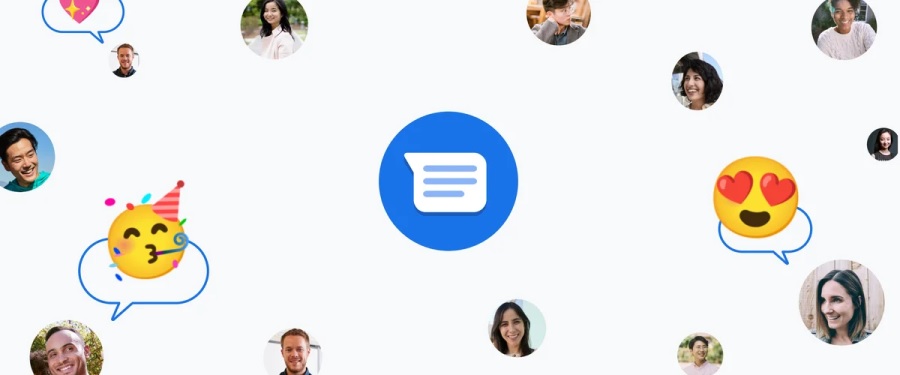In a clever Romeo and Juliet-themed ad by Samsung, Google is once again exerting more pressure on Apple to get the message and adopt RCS so that everyone can hang out together in chats without worrying about blue or green bubbles. Romeo, whose parents are supposedly Android, is texting Juliet asking why her parents, Apple in this fairytale, won’t let them chat via RCS, and instead they have to deal with green bubbles. Juliet says she tried to convince them but they won’t budge. She doesn’t understand why her parents keep them apart yet everyone else supports their union.
It’s cute of Google (and Samsung) to come up with something based on Romeo and Juliet’s love story. But how did we get here? Why is Google and Samsung “ganging up” to force Apple into adding RCS support to iMessage?
To understand the situation better, let’s start by debunking what RCS is.
What is RCS?
RCS, or Rich Communications Services, is a GSMA-approved online protocol meant to replace SMS as the texting standard, allowing people to add GIFs, photos, videos, and other multimedia capabilities to text messages. The GSMA says RCS’s Universal Profile is a “single, industry-agreed set of features and technical enablers.”
But before we get too far ahead, here’s some background on how we got here and why RCS is increasingly becoming a necessity in messaging.
Why is RCS required?
A couple or so decades ago, sending someone a text message was as simple as getting their phone number and sending them an SMS, short for Short Messaging Service. This was made easier since phones have an SMS app out of the box. But with SMS file size capped at 160KB, sending rich or longer messages was impossible. This gave birth to MMS, short for Multimedia Messaging Service, allowing people to not only send GIFs, but also richer files like emojis and even photos. But again, the 600KB file size limit became an issue as technology kept advancing and people moved from feature phones to smartphones.
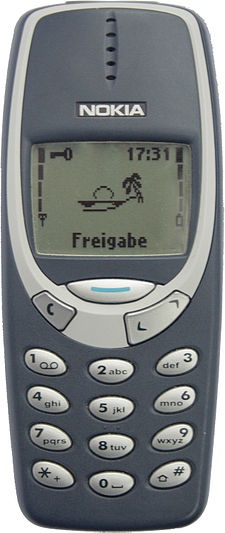
As noted, every phone ships with a pre-installed SMS app, including the iPhone, which has the Messages app as the default for text messaging services. But like before, and with more technological advancement, people grew beyond what SMS and MMS could offer in terms of rich communication. For Apple, the solution was to build an instant messenger into its Messages app that relies on internet for rich communication. iMessage is the app in question, where you can send rich messages to other iPhone users, but the app defaults to SMS and MMS if the recipient is an Android user.
With iMessage, you are getting so much more than what SMS and MMS have to offer. Beyond using the internet, iMessage has typing indicators, read receipts, message reactions, 100MB file limit, multiple file formats, inline replies, location sharing and so on. Even better is you also get end-to-end encryption that makes it more secure than SMS and MMS. If you own other Apple products like iPad, Mac and the Watch, it syncs across all of them so that your messages are easily accessible from any device. But as you’d expect from Apple, iMessage isn’t available on non-Apple products, which is where RCS comes in.
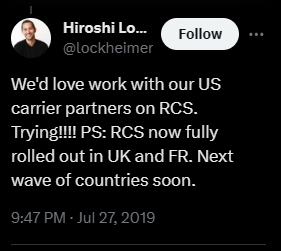
Essentially, RCS turns the typical SMS app into some form of super app with multimedia capabilities to suit the modern day user. Just like iMessage, you can send GIFs, photos, videos, see your friend’s online status before texting them, read receipts, typing indicators, create longer messages, attach larger files, and even chat in groups. However, both the sender and recipient must be using RCS-enabled devices or apps for that matter for this to work, something that’s still missing on iMessage.
5 years later, Apple still won’t budge
Google started the RCS push in 2018. Rather than each company adding RCS support to their individual apps, Google convinced them to replace their apps with the Google Messages app for easier transitioning. So far, multiple smartphone vendors have already adopted Google’s Messages app, which relies on the company’s Jibe RCS backend, as the default on Android. This includes big industry players like Samsung. Several carriers have also adopted RCS for their text messaging apps, O2 UK among the latest to join the party.
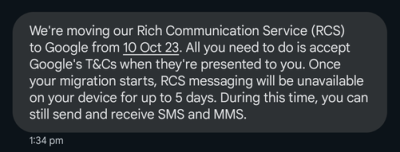
It’s been over a year since Google launched the ‘Get the Message’ campaign to pressure Apple into adding RCS support to the iMessage app on iPhone. But so far, Cupertino hasn’t flinched. During this period, Google made several other attempts, including a teaser at the I/O 2023 and an iPager ad a few weeks ago. But the most recent attempt by Samsung amps things a notch higher or perhaps shows how desperate things are getting, depending on which side of the fence you are.
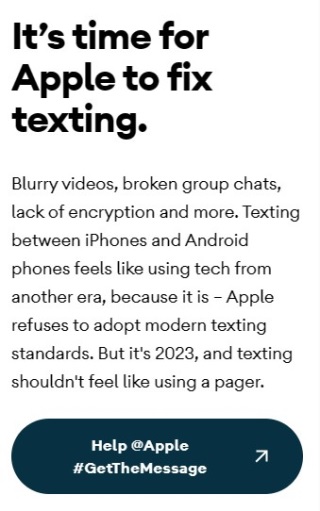
What’s taking Apple so long to add RCS in iMessage?
There’s no sign that Apple will be joining the RCS bandwagon anytime soon. But with the EU — and we all know what they can do — there’s no ruling out the possibility of iMessage supporting RCS in future. Still, what’s taking Apple so long or rather why hasn’t iMessage received RCS support to date?
The love for default apps
Most people use the default apps on their phones primarily because setting up another app is a cumbersome process to them. Furthermore, you also need to convince your social circle to download and install a 3rd-party app in order to use it, something that isn’t always easy. Given that Apple controls most of the U.S. smartphone market, there’s simply no major incentive for them to accommodate Android users by adopting RCS. Apple wants Android users to feel left out and in the process join their happy iPhone counterparts. Outside the U.S., the blue vs green bubbles war is pretty much non-existent. People use apps like WhatsApp and Facebook Messenger for text messaging, which means iMessage having or not having RCS support doesn’t really matter to them.
iMessage lock-in
With how popular the iPhone is in the U.S. coupled with the fact that people simply prefer using the default messaging app on their phones, Apple sees no reason to hurry RCS integration with iMessage. In fact, Apple has ensured that iPhone users know that a switch to Android will not only mean they lose iMessage and its rich texting features, but they also risk becoming a “green bubble”. No one wants to be on the receiving end of the green bubble memes, so instead of switching from iPhone, it’s more of Android users looking to switch to iOS so as not to feel left out or rather join the side with blue bubbles.
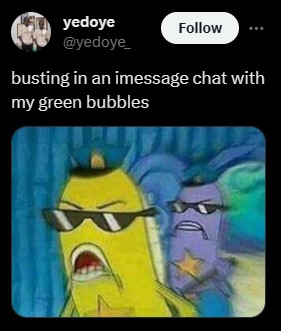
If most people around you own an iPhone and use the default iMessage app for texting, sharing locations, group chats and all the fancy stuff, it’s easy to join them than convince them to join you. This is what Apple banks on, and so far, it’s working for them and hence the stubbornness to be part of RCS. Sure, there are alternatives like iMessage for Android, but this is something Apple has ruled out. The company is aware that they’ll lose their leverage by unlocking iPhone-to-iPhone features for Android users, and no one ever wants to lose their leverage, especially one as big as the iMessage lock-in.
Google has a habit of killing products
Google recently promised 7 years of OS updates for Pixel 8 and Pixel 8 Pro buyers. But there are already doubts over whether the company will keep this promise. This came on the backdrop of discontinuing Google Podcasts, a service that is just one among many that Google has killed over the years. That said, you’d understand Apple’s hesitance to join up with Google on a messaging platform that has little-to-no reward for iOS users. This is especially true considering Google’s history with messaging platforms. The search giant has had so many messaging apps and it’s just hard to trust whether this effort to adopt RCS will be the same a decade from now.
Privacy & security of messages
There are fears that Google pushing Apple to adopt RCS means iPhone messages will go through Google’s servers to get to Android users. Given the privacy and security issues with Google products, you’d understand the resistance from the Apple community in general. However, this isn’t the case, especially since messages on Google’s RCS are also end-to-end encrypted.
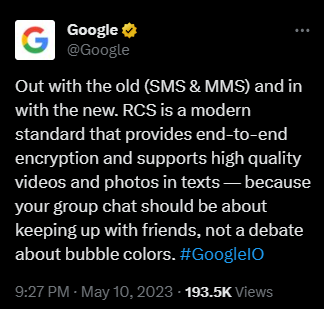
As noted earlier, RCS has a Universal Profile, think of it as an API where every player can build their own take on RCS using the profile. Google’s version is Jibe, and Apple can have its own version too to replace the SMS/MMS standard in iMessage. However, the fact that this RCS Universal Profile is not controlled by Apple probably makes them wary of potential privacy and security issues in future. After all, we all know Apple has built its reputation on promising their customers top-notch privacy and security features.
iMessage is an app made by Apple, runs on Apple servers and works on Apple products, making more secure. On the other hand, RCS is a messaging service being pushed by Google, runs on Google’s Jibe cloud, works on a Google app and is used on an Android OS owned by Google. There’s just so much going on that isn’t in Apple’s control, and for a company that is a control freak, this deal stinks.
Conclusion
As things stand, Apple hasn’t indicated that it will be adding RCS support to iMessage or not. Even with the Samsung RCS ad, the message is still clear: you must buy an iPhone to get rid of green bubbles in messages. But regardless of what happens, I still want them to enable the function.
There’s no privacy concern given that end-to-end encryption is also guaranteed in RCS messaging. Kids shouldn’t have to skip school just because their mates won’t let go of the green bubbles jokes. And all it takes is for Apple to flip the switch on, which, of course, is easier said than done.
Featured image: Google
PiunikaWeb started as purely an investigative tech journalism website with main focus on ‘breaking’ or ‘exclusive’ news. In no time, our stories got picked up by the likes of Forbes, Foxnews, Gizmodo, TechCrunch, Engadget, The Verge, Macrumors, and many others. Want to know more about us? Head here.

